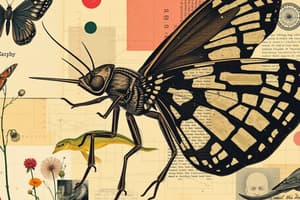Podcast
Questions and Answers
What challenge is posed by convergent evolution in biological classification?
What challenge is posed by convergent evolution in biological classification?
- It aids in the determination of phylogenetic relationships.
- It establishes clear and distinct classifications.
- It simplifies the taxonomic categorization process.
- It creates misleading similarities among species. (correct)
Which of the following technologies is NOT typically used in modern biological classification?
Which of the following technologies is NOT typically used in modern biological classification?
- DNA and protein sequencing
- Comparative genomics
- Molecular cloning (correct)
- Phylogenetic analyses
Why must biological classification be considered a dynamic process?
Why must biological classification be considered a dynamic process?
- New species are continuously discovered. (correct)
- Existing classifications are always accurate.
- Technological advancements do not impact classification.
- It is dependent on fixed characteristics.
What role do bioinformatics play in modern classification?
What role do bioinformatics play in modern classification?
What can unresolved taxonomic issues indicate?
What can unresolved taxonomic issues indicate?
What is the primary purpose of biological classification?
What is the primary purpose of biological classification?
Which level of biological classification is the broadest?
Which level of biological classification is the broadest?
Which of the following is a key feature of the Linnaean system of classification?
Which of the following is a key feature of the Linnaean system of classification?
What method is used to visually represent evolutionary relationships among organisms?
What method is used to visually represent evolutionary relationships among organisms?
Which characteristic is NOT traditionally used in biological classification?
Which characteristic is NOT traditionally used in biological classification?
How do molecular data contribute to biological classification?
How do molecular data contribute to biological classification?
What is a limitation of classification systems mentioned in the content?
What is a limitation of classification systems mentioned in the content?
Which of the following is NOT a primary level of biological classification?
Which of the following is NOT a primary level of biological classification?
Flashcards
Taxonomic Challenges
Taxonomic Challenges
Some species don't fit neatly into existing classifications, highlighting unresolved taxonomic issues.
Evolutionary Mismatches
Evolutionary Mismatches
Classifications may not perfectly reflect evolutionary relationships.
Modern Classification Tools
Modern Classification Tools
Computational data analysis and bioinformatics are crucial for modern classification.
Phylogenetic Analyses
Phylogenetic Analyses
Signup and view all the flashcards
Dynamic Classification
Dynamic Classification
Signup and view all the flashcards
Biological Classification
Biological Classification
Signup and view all the flashcards
Levels of Biological Classification
Levels of Biological Classification
Signup and view all the flashcards
Domain
Domain
Signup and view all the flashcards
Binomial Nomenclature
Binomial Nomenclature
Signup and view all the flashcards
Phylogenetic Classification
Phylogenetic Classification
Signup and view all the flashcards
Morphology
Morphology
Signup and view all the flashcards
Physiology
Physiology
Signup and view all the flashcards
Molecular Data
Molecular Data
Signup and view all the flashcards
Study Notes
Introduction to Biological Classification
- Biological classification groups organisms by shared characteristics and evolutionary relationships.
- This system organizes Earth's biodiversity, aiding in study and understanding relationships.
- Classification systems adapt as our understanding of evolutionary processes improves.
Levels of Biological Classification
- Classification is hierarchical, broader categories including more specific ones.
- Key levels are: Domain, Kingdom, Phylum, Class, Order, Family, Genus, and Species.
- Domain, the broadest, includes Bacteria, Archaea, and Eukarya.
Importance of Classification
- Provides a universal language for scientists.
- Enables the identification and naming of organisms.
- Reveals evolutionary relationships between groups.
- Organizes biodiversity for easier study.
- Predicts characteristics of new species based on their classification.
Linnaean System of Classification
- Developed by Carl Linnaeus, using binomial nomenclature (two-part names).
- Species names include the genus (e.g., Homo) and species (e.g., sapiens).
- This foundational system, while outdated in parts, remains a basis of modern species understanding.
Modern Methods of Classification
- Phylogenetic classification reflects evolutionary relationships.
- Evolutionary trees (cladograms) represent these relationships.
- Molecular data (DNA and protein sequences) build accurate evolutionary trees.
- This method emphasizes derived characters distinguishing related groups.
Criteria for Classification
- Morphology (physical traits) is a fundamental criterion.
- Anatomical structures help classify organisms.
- Physiological traits are considered.
- Geographic distribution suggests relatedness.
- Behavioral similarities are helpful.
- Molecular data (DNA analysis) offers insights into ancestry and relatedness.
Limitations of Classification Systems
- Systems are dynamic, continuously refined by new research.
- Limitations stem from incomplete knowledge of evolutionary history.
- Some species' characteristics don't neatly fit; unresolved taxonomic issues exist.
- Classifications may not perfectly represent evolutionary branching; convergent evolution can create misleading similarities.
Modern Tools in Classification
- Bioinformatics and computational analysis are vital in modern classification.
- Phylogenetic analyses use sophisticated algorithms for evolutionary relationships.
- Advanced techniques, like DNA/protein sequencing and comparative genomics, are essential tools.
Conclusion
- Biological classification is dynamic, continually refining our understanding of Earth's biodiversity.
- New technologies and deeper evolutionary understanding drive system refinements.
- Critical for recognizing and understanding diverse and interconnected species.
Studying That Suits You
Use AI to generate personalized quizzes and flashcards to suit your learning preferences.




